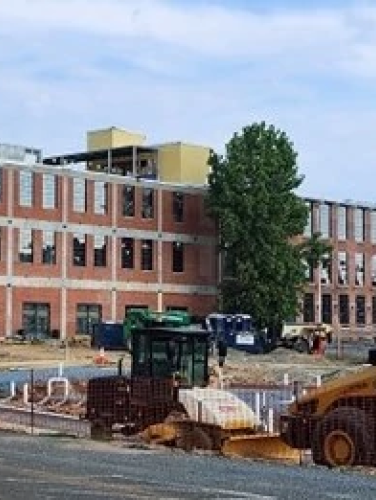
Savona Mill
(ca. 1916)
The Savona Mill is an excellent example of the evolution of both the textile industry and industrial architecture.
528 South Turner Ave., Charlotte, NC 28208
The Savona Mill is an excellent example of the evolution of both the textile industry and industrial architecture as the building developed in three distinct phases, each with period-specific innovations of construction techniques and materials used by industrial designers during the twentieth century. By 1908, when the Savona Manufacturing Company was incorporated by a group of New York-area businessmen, Mecklenburg County had already become the home of the third most textile mills within the state of North Carolina in just two decades. The founders of the Savona Mill focused their production efforts on fine finished textiles using cotton damask weaving techniques. Operations began in rented manufacturing space in downtown Charlotte.
Property Quick Links
Firmly established as a going concern by 1914, the Savona Company expanded operations to a South Turner Avenue property two miles northwest of downtown. Adjacent to the Piedmont and Northern Railway line, the new site provided convenient access for both delivery of unfinished materials and shipping of goods. The one-story Weave Mill, completed in 1916, was designed by Lockwood Greene Company, the foremost industrial designers of the era. Built of traditional heavy timber mill construction, the facility increased the company’s manufacturing space, allowing operation of its existing machinery in a structure specifically designed for its manufacturing process.
In 1921, the three-story Spinning Mill – based upon the designs of prominent North Carolina mill engineer and architect Richard C. Biberstein – was built on the north side of the Weave Mill with such then-novel structural and finish materials as a poured concrete foundation, timber beams and floors, and metal columns. Those materials provided greater support strength with narrower columns, providing more interior space to make work easier and more efficient. That expansion doubled the size of the company’s operations, providing additional space for processing raw cotton into thread and installation of 30,000 spindles for the spinning of yarn. By controlling the entire manufacturing process from raw material to finished products on one site, Savona could better control its supplies and the efficiency of its operation. By 1925, the mill employed 550 workers, had 18,000 spindles on 950 looms, and provided housing for 100 families.
All textile production ceased at the Savona site in 1934. The property was acquired in 1935 by the Old Dominion Box Company, a manufacturer of packaging materials for a variety of retailers. Old Dominion constructed the three-story Paper Warehouse addition in 1951 at the north end of the Spinning Mill with a reinforced poured concrete frame, brick infill walls, and steel sash windows, providing strength for its industrial operations, space for manufacturing, and fireproof storage for the safety and protection of its combustible inventory. The facility operated until the 1990s when Old Dominion ceased production at the South Turner Avenue property.

